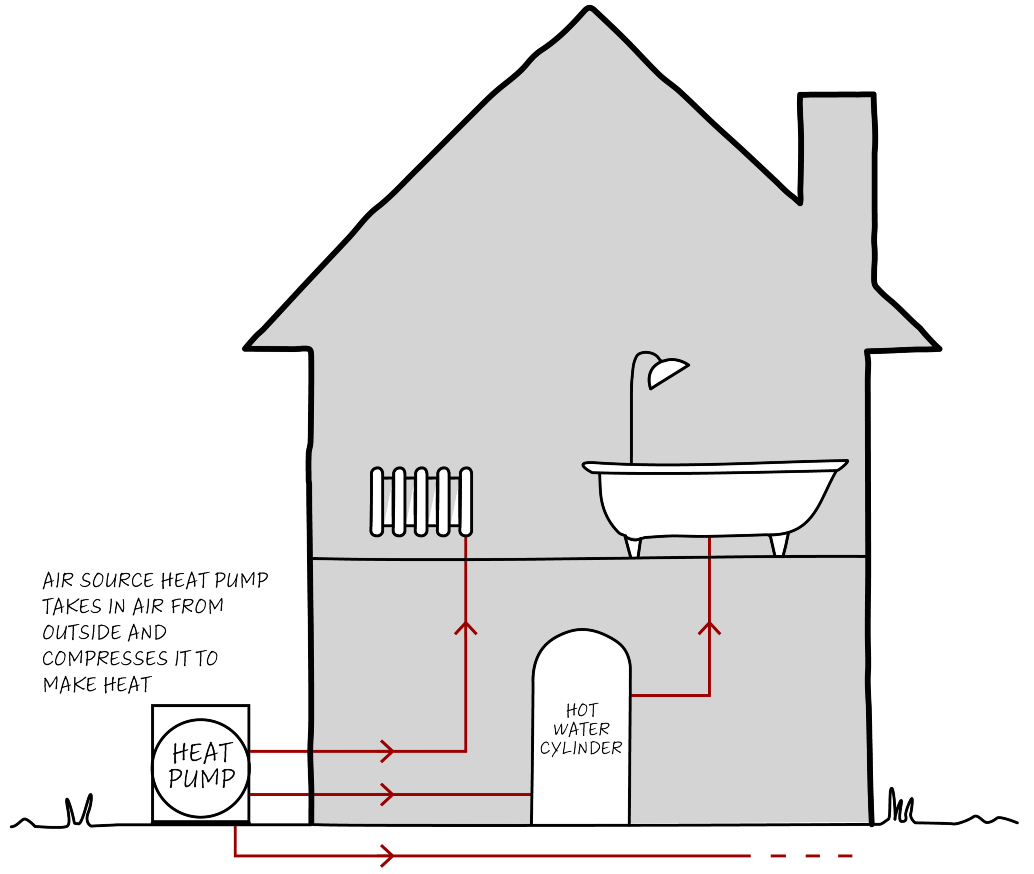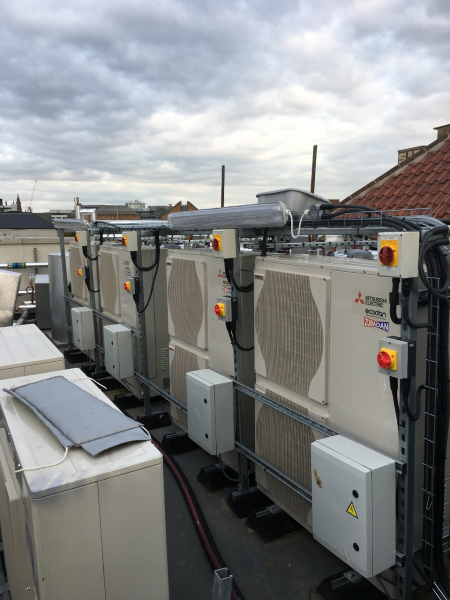

Air Source Heat Pumps can be used for heating and cooling spaces in a building. Using the same compression cycle mechanism as a fridge in reverse, they take heat energy from the outside air and transfer it to a refrigerant. The refrigerant is then compressed which significantly increases its temperature and the heat is utilised to heat your home and your hot water.
An ASHP is so efficient that it supplies roughly 3 times as much heat energy to the system as it consumes in electrical energy, making them over 300% efficient.
Air Source Heat Pumps are now the low-carbon heating option being promoted in B&NES and elsewhere. They are extremely effective. For perspective, while a modern gas boiler is more than 90% efficient – and electric heaters are 100% – air-source heat pump efficiency can be 300 to 400% higher.
Air Source Heat pumps are recommended, where possible, to replace oil, log and gas boilers as well as direct electric heating systems (subject to feasibility).
Carbon efficiency will depend, in part, on how green your electrical supplier is. However, in any case, it is still one of the lowest carbon heating solutions available.
Heat pumps work most efficiently with underfloor heating. Where this is not possible, conventional radiators can be used effectively for space heating using water heated with an air source heat pump. Radiators should be correctly sized to the needs of the home using a full heat calculation for the property to design the system.
They can work well when combined with PV Panels and/or battery storage.
Their high efficiency means that an ASHP’s running cost can be far lower than what you'd typically pay for an oil-fired or electric heating system and is comparable to gas. An ASHP typically costs less than a Ground Source Heat Pump to install, but note that they have potentially higher maintenance and replacement costs.
Heat pump heating systems work best for homes with a good level of insulation and controllable ventilation. In poorly insulated homes, the running costs may be higher but the carbon emissions will be much lower, especially if the home uses a renewable energy electrical tariff or generates its own with PV panels.
Noise emissions should be considered and mitigated where needed with a silencing enclosure, or by locating the unit further from sensitive facades.
The location of the very cold air exhaust from ASHPs should be carefully considered to avoid ‘cold plumes’ to occupied external areas, or areas where ice may proliferate.
Heat pump systems cannot be used for instantaneous hot water like a combi boiler and space will be required for a correctly sized hot water tank.
When installed inside the building, ductwork may need to pass through the wall of the building and they will take up space internally.
If you intend to also use the heat pump for cooling, this should be built into the initial design.
Listed Building Consent is required for an air source heat pump.
Buildings of a traditional construction require a level of passive natural ventilation and the design of the heat pump system will need to allow for the lower levels of insulation and higher rate of ventilation.
Care should be taken to locate the external unit of an air source heat pump in a discreet location away from the principal elevation – this could include behind greenery or fencing. You can also find ducted ASHP units which can be located indoors.
If under-floor heating is not possible, radiators may be considered. In some cases, historic radiators may survive and are likely to be considered as significant elements of the interior and therefore their retention is important. Where this is not the case, new radiators should be of a discreet design and sensitively-located.
Older properties often contain microbore pipework, which may need to be carefully replaced as it is not usually compatible with a heat pump.
When used for space heating, heat pumps work most efficiently with under-floor heating. This is unlikely to be appropriate where there are significant historic floor surfaces which could be harmed from being lifted. However, where there is not the case, such as where there is already modern, replacement flooring, under floor heating may be possible. In which case, it is highly recommended that limecrete is used which can be used in conjunction with insulation and under floor heating systems whilst allowing the transfer of moisture.
We support the installation of air source heat pumps where there is no detrimental impact on the architectural or historic interest of the building, and they can be discreetly located.
In the light of the Climate Emergency, we will generally permit and encourage alterations on listed buildings, with special regard to the the following:
- Preserving the building, its setting or any features of special architectural or historic interest which it possesses
- Preserving or enhancing the character of a conservation area
- Respecting the significance of any non-designated heritage asset
Historic England’s Guidance on Heat Pumps
Air source heat pumps from the Centre for Sustainable Energy
